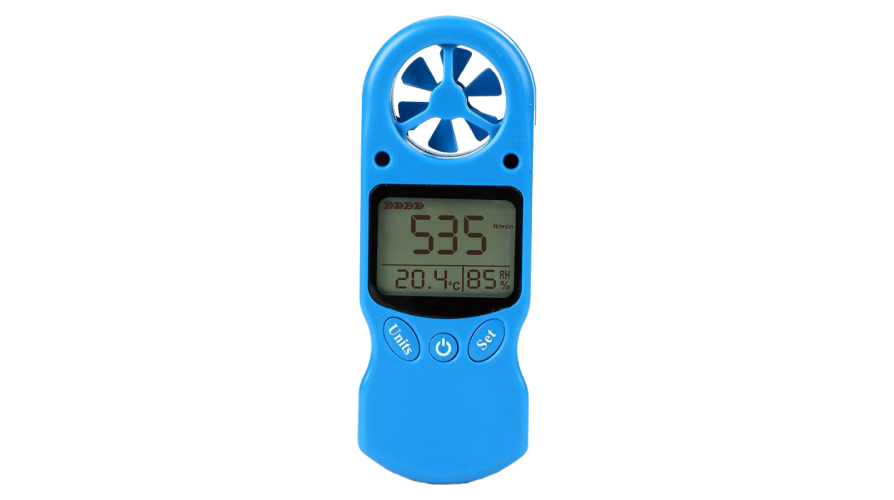All You Required to Know About Anemometers: Just How They Function, Why They Issue, and Where to Use Them
Anemometers, though commonly overlooked in the realm of scientific tools, play an essential duty in various areas, supplying valuable understandings into wind rate and air flow patterns. As we delve right into the details of anemometer innovation, we will reveal the inner operations of these tools, their importance, and the key factors to consider when picking the appropriate anemometer for details applications.

Anemometer Basics
A necessary instrument made use of to determine wind speed and direction, the anemometer plays a critical duty in weather forecasting and numerous industries. An anemometer usually is composed of three or four cups that turn in the wind, a vane that aims into the wind, and sensors to track the turnings or motions. By calculating the rotations or movements over a particular period, the anemometer can figure out wind rate. The vane aids figure out wind direction by directing right into the wind, providing useful information for weather condition forecasting, aeronautics, maritime procedures, environmental monitoring, and wind power applications.
There are various types of anemometers offered, consisting of cup anemometers, vane anemometers, hot-wire anemometers, and sonic anemometers, each with its special attributes and applications. Cup anemometers are typically utilized for standard wind speed dimensions, while vane anemometers are preferred for directional dimensions.
Principles of Anemometer Procedure
Building on the fundamental understanding of anemometer essentials, the principles of anemometer procedure elucidate the technicians behind wind rate and instructions dimensions. Cup anemometers, for circumstances, have 3 or more mugs that record the wind, triggering them to rotate much faster as the wind speed increases. Hot-wire anemometers depend on a warmed cord that cools down as wind passes over it, with the price of cooling identifying the wind rate.
Significance of Anemometers
Anemometers play a vital duty in measuring wind rate and direction, supplying necessary information for climate projecting, climate studies, ecological tracking, and air travel procedures. Meteorologists rely on anemometers to collect precise wind information, assisting them understand weather condition patterns, anticipate tornados, and problem timely warnings to the public. Wind ranch drivers utilize anemometers to examine wind problems and maximize electricity manufacturing from wind generators.
Applications Throughout Various Industries
Applications of anemometers extend throughout varied sectors, showcasing their convenience and utility beyond weather forecasting. In the eco-friendly energy field, anemometers play a vital role in analyzing wind problems for wind farm placements, making certain ideal power production. Industries like building and mining make use of anemometers to keep an eye on wind rates, important for security protocols, particularly when functioning at elevations or in open-pit mines where solid winds can position threats. Anemometers are likewise indispensable in the aviation industry, helping pilots in recognizing airspeed and wind instructions for secure take-offs and touchdowns. The maritime sector advantages from anemometers for ship navigation, assisting seafarers anticipate climate modifications and adjust courses appropriately. In agriculture, anemometers aid farmers in managing crop splashing by providing real-time information on wind rate to avoid drift. Anemometers locate applications in HVAC systems to enhance airflow and enhance energy performance in structures. The varied usage cases of anemometers underscore their significance across different markets, highlighting their vital duty in enhancing operational safety and effectiveness (anemometer).

Choosing the Right Anemometer for Your Requirements
For general functions, a cup anemometer is ideal for measuring wind speed, while a vane anemometer provides wind instructions data. Hot-wire anemometers are optimal for low airspeed measurements, and ultrasonic anemometers offer high accuracy and toughness.

Verdict
To conclude, anemometers play a critical function in gauging wind rate and direction throughout various sectors. Understanding the principles of anemometer procedure is vital for selecting the right device for specific demands. From meteorology to aeronautics, anemometers are essential devices for making certain and accumulating precise information security in various applications. It is essential to consider the significance of anemometers in order to make informed choices when choosing one of the most appropriate tool for determining wind problems.
There are different kinds try these out of anemometers readily available, including cup anemometers, vane anemometers, hot-wire anemometers, and sonic anemometers, each with its one-of-a-kind features and applications. Cup anemometers are frequently made use of for fundamental wind speed dimensions, while vane anemometers are preferred for directional measurements. Hot-wire anemometers are suitable for reduced airspeeds, visit this web-site and sonic anemometers are suitable for high-precision dimensions in study and commercial setups.Building on the fundamental understanding of anemometer basics, the principles of anemometer operation elucidate the mechanics behind wind rate and instructions dimensions. For basic objectives, a cup anemometer is suitable for gauging wind rate, while a vane anemometer provides wind instructions information.